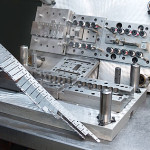Have you ever wondered how metal spring clips are made? One ideology that holds true with just about every identifiable item we know of is that the longer they have been around, the more time they have had to evolve. The same holds true for the everyday household springs we use today. The coiled spring has a history that dates back to the early part of the 15th century, where you would originally find it indoors and, towards the end of that century, clocks. While the concept of the spring has stayed the same, the varieties and manufacturing practice has grown and changed greatly. One style of spring that is heavily relied on today by industries from residential to military, aeronautics and even personal application is the metal spring clip. Just like with the conventional coiled spring, metal spring clips have evolved in the way of their production.
With a rich company history of over 50 years, the means of our production here at Atlantic Precision Spring has grown and evolved in its own way. Today, we rely on machinery people probably couldn’t imagine having access to 50 years ago, let alone conceptualize in the 15th century! We can create our custom and flat metal spring clips use top-of-the-line metal stamping equipment along with state-of-the-art technology. Let’s start by taking a deeper look at spring clips themselves.
Metal spring clips and clamps are a crucial piece to countless tools, machines, vehicles, buildings, and accessories. We’re proud to be a metal spring clip supplier offering springs in the following materials:
- Aluminum

- Stainless Steel
- Brass
- Beryllium
- High Carbon Steel
- Low Carbon Steel

- Nickel
- All types of bimetal
Additionally, depending on the specifications of your needs, we can help you figure out exactly what material or style spring clip you require. We can supply a spring clip force calculation along with a sample material force measurement to help you find your perfect solution.
When it comes to the production of our custom metal spring clips, we utilize two types of machines- power presses and fourslide machines. Each of these machines has its own respective benefits when it comes to spring production. Let’s take a look at each.
Power Press
Our power presses operate through a process we refer to as progressive die stamping. The power presses we have ranges in size from 25 to 100 tons, which gives us versatility in producing a large portfolio of materials in a quick window.
The extreme accuracy of this machinery allows us to handle tight tolerances with ease. Furthermore, we frequently require our staff to be trained and retrained in procedures and operations of the power press, so that they are as efficient as possible while working on various projects.
In addition to staff training, it is important to make sure the machinery is current with the always growing options and upgrades. This is why we will occasionally do complete evaluations of our machinery and equipment. And while that can cause a slight delay in production, it ensures we can maintain the high level of our product quality our customers have grown to expect.
Fourslide Machine
Fourslide machines maintain a rigorous maintenance schedule allowing us to keep our metal clips to tolerance requirements. Fourslide stamping gives us the ability to achieve what we consider “multi-side stamping.” The fourslide process is perfected by using a combination of 3D design software along with in-house Computer Numerical Control (CNC) and Electrical Discharge Machining (EDM). The process not only requires less tooling than progressive die sets but can also be assembled in a fraction of the time. So, any potential customer interested in receiving a higher quality product faster while still being more affordable (or, in other words, every customer), is thoroughly satisfied when we use our fourslide machine on their product.
Once we know which type of spring clip we are making, a small strip of material is inserted into the forming and piercing portion of the machine. After that, with the strip now in the shape of a progressive tool, the strip enters into the cut off section of the fourslide machine. It is after this step that a shaping tool is introduced and begins shaping the material to its final, designed form. There can be multiple slides available for additional tool attachment for any spring clip with a more complex design or shape.
Both power press and fourslide printing have their own respective benefits, it all comes down to your needs. If you are wondering which process would work best for you, why not talk to the people who deal with them most often? Contact our trained staff with what you are looking for and, after developing a 3D model, we can walk you through which process will lead to the metal spring clip you are looking for!

